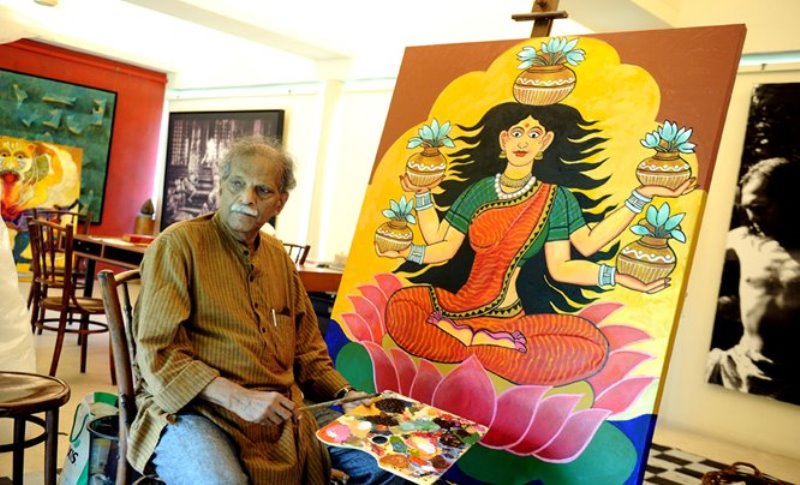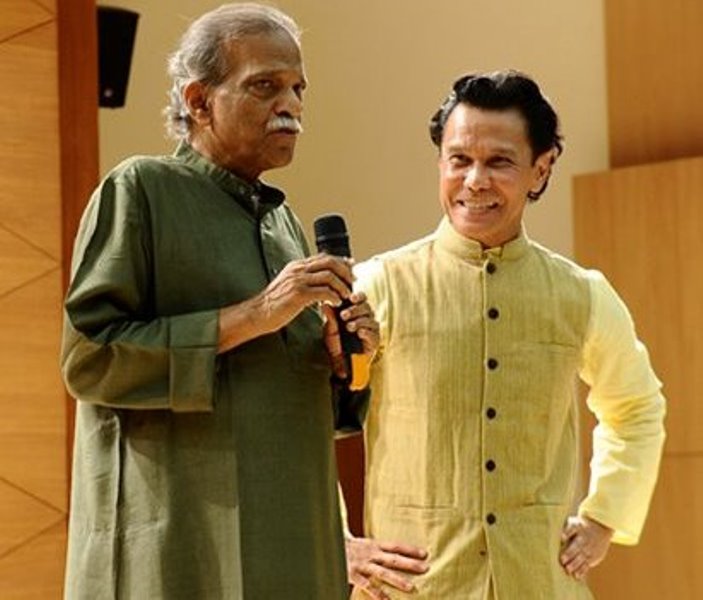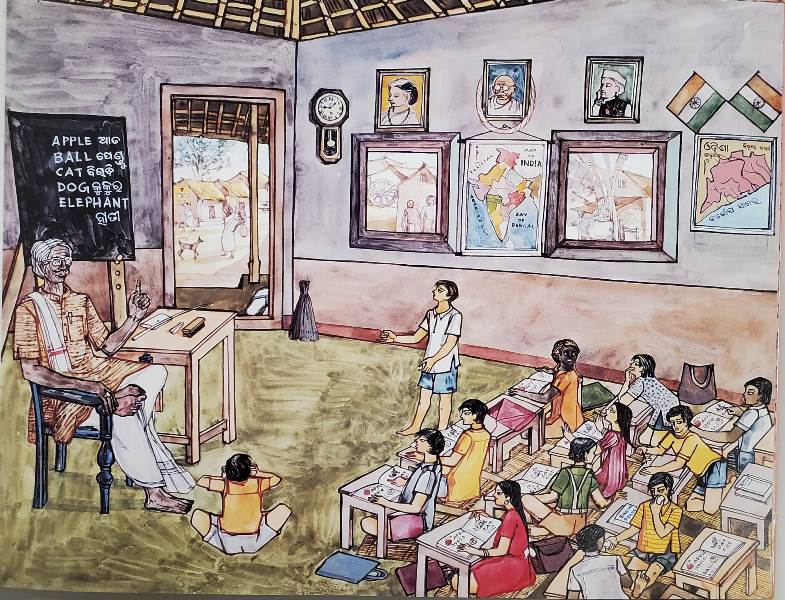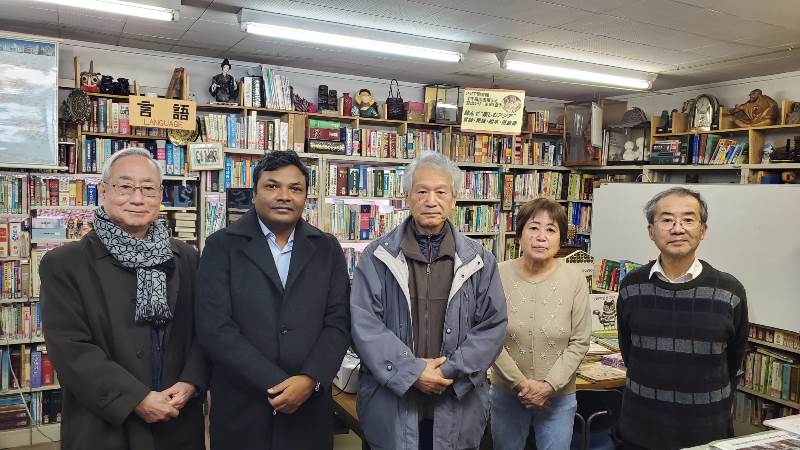 Dinanath Pathy
Dinanath Pathy Finding Dinanath Pathy's 'Geeta' in Osaka
Nikhilesh Giri, an Indian diplomat currently posted in Japan, writes about late Odiya painter and art historian Dinanath Pathy after he chanced upon his illustrations in a children's book in Osaka's Asian Library.
Dinanath Pathy was a giant in the firmament of Indian literary, visual and performing arts. His unassuming demeanour, sartorial asceticism and earthy gait, however, didn't give away the immensity of his persona. Only those who had followed his extraordinary body of work or were fortunate to have had a personal acquaintance with him would realize how big a void his passing away created in the art-scape of India.
I had the privilege of knowing him briefly while living in Kuala Lumpur, where he was a frequent visitor to the Sutra House. Over the course of two decades, the latter's founder Padma Shri Datuk Ramli Ibrahim - an eminent Odissi dancer and artistic director - and Dr. Pathy had collaborated prolifically on a rich and varied array of cultural projects. Datuk Ramli has recounted these projects and his fond kinship with Dr. Pathy in a moving piece titled 'A Sutra Tribute to a Beacon of Art’ that is widely available on the web.
Dr. Pathy was deeply hurt to see the general apathy of Indian society towards art and artists. He complained that emphasis, if any, on incorporating art or art appreciation in our school curricula was given a mere lip service. It is difficult to disagree with him. There is so much pressure from parents and teachers alike on the children to be singularly focused on text books that they grow up believing art and similar subjects are avoidable distractions.
My own interest in art and culture remained perfunctory for a substantial period. A fortuitous encounter with Datuk Ramli and Dr. Pathy however changed that. Between September 2015 and July 2016, Dr. Pathy visited Kuala Lumpur a few times in connection with the premiere of Sutra's two beautiful Odissi co-productions - 'Ganjam' with Guru Gajendra Panda and 'Amorous Delight' with Guru Meera Das.
 Dinanath Pathy and Ramli Ibrahim at Malaysian High Commission, New Delhi during Quintessential Sutra book release (April 2016). Photo: A. Prathap
Dinanath Pathy and Ramli Ibrahim at Malaysian High Commission, New Delhi during Quintessential Sutra book release (April 2016). Photo: A. Prathap
He had a major part in conception of the two projects. Every time he visited Malaysia, he would bring with him several artists and writers from India, whom he had taken under his tutelage. Among them were dance critic Leela Venkataraman, painter Ramahari Jena, author and historian Prof. Jatindra Kumar Nayak, and visual artist and graphic designer Jyotiranjan Swain. Dr. Pathy had come to our house for dinner once, and he had brought as present a set of his literary works, including a book he had co-authored with renowned German art historian, ethnologist and author Padma Shri Dr. Eberhard Fischer.
A few months after Dr. Pathy’s demise, I met his son Soubhagya Pathy, himself a gifted scholar and writer, in Bhubaneswar. Like his father, Soubhagya Pathy was also very generous with his affection. Knowing my interest in Dr. Pathy's writings, he gave me a set of his father’s fictional and non-fictional works in Odia from their private library. The books had already gone out of print and were thus very precious.
Two of them - one a biographical anthology on pioneering Odia painters and the other a chronicle of Odisha's theatre tradition - left a deep impression on me. Both the books narrate the superiority of the craftsmanship of these artist(e)s as also the enormity of hurdles they faced in their lives. Several of them lived in penury and died in anonymity due to lack of adequate patronage and support from the government and the society.
Dr. Pathy himself did not get the recognition that was due to him in his lifetime. He had devoted his life to a relentless mission to globalize Odisha's art. Yet, he remains unknown to a large majority of people in Odisha. He was instrumental in building many pioneering institutions for promotion of art and culture. It would be gratifying if these institutions could help in the preservation and popularization of his literary and artistic creations in India and abroad.
 An illustration by Dinanth Pathy from the Japanese children's picture book 'Geeta: The Indian Girl' (Photo taken with permission from Asian Library, Osaka)
An illustration by Dinanth Pathy from the Japanese children's picture book 'Geeta: The Indian Girl' (Photo taken with permission from Asian Library, Osaka)
I have seen a minuscule portion of Dr. Pathy's original drawings and paintings. So I was delighted to see a children's book in Japanese full of Dr. Pathy’s sketches and illustrations at the Asian Library in Osaka. The book, meant to introduce Japanese kindergarten students to Indian rural life, is in fact a translation from the original German edition by Dr. Pathy, Dr. Eberhard Fischer and Barbara Fischer. The text and pictures in the 32-page book pivot around a child protagonist 'Geeta'.
The Asian Library has an interesting story of its own. A few paces from the Awaji station, on a small by-lane in Awaji ward of Osaka stands a diminutive, two-floor house with an unimposing and jaded facade. A row of Ceylon creepers hides the wall.
The rusting edges and faded paint of the large metallic billboard gives away its age. The text on it reads Book Land, a jungle of books. Behind this modest exterior lies a giant institution. Set up in 1981, the library was the brainchild of late Prof. Sandip Tagore, a scholar, painter and musician, who lived in Japan for more than 60 years. The Government of India gave him the Pravasi Bharatiya Samman award in 2017 in recognition of his contribution to the furtherance of cultural relations between India and Japan.
 Sakaguchi Katsuharu (middle) at the Asian Library, Osaka ( February 2022).
Sakaguchi Katsuharu (middle) at the Asian Library, Osaka ( February 2022).
Ably led by Sakaguchi Katsuharu, the Asian Library has not only survived for the past 41 years, but it has also grown in size, scale and ambition. Today, it houses over 500,000 books in more than 30 Asian languages and conducts classes in 33 languages, among them Bengali, Hindi, Tamil and Urdu from India. Its other activities include promotion of cultural exchanges between Japan and various other Asian countries.
It is remarkable that at a time when public libraries in different countries are vanishing because of diminishing patronage, the Asian Library is able to sustain its activities with members’ subscriptions and voluntary donations. When Prof. Tagore was alive, he used to organize many cultural events with the support of local as well as foreign artists to raise funds for the library. Unfortunately, this has stopped now.
The picture book ‘Geeta’ was published in 1983 by yet another remarkable institution called the Japan Asian Association & Asian Friendship Society (JAFS), set up 4 years earlier. Headquartered in Osaka, JAFS continues to do notable work in the fields of education and environment in developing countries from Asia and Africa. Several Indian villages have benefited from their philanthropic work.
Dr. Pathy had visited Japan a few times. He had even been a recipient of a Japan Foundation fellowship. I have seen his photographs in private albums of some Japanese Odissi exponents living in the Kansai region, many among whom are members of the JAFS. But it is not certain if he ever visited the Asian Library. Mr. Katsuaru, its lone keeper in all these years, does not recall having met him.
During our conversation about Dr. Pathy’s work in the fields of art and literature, Mr. Katsuharu enquired if the book ‘Geeta’ was available in Odia. He even offered to support its publication or reproduction, as necessary. I promised to check and revert to him on this. It occurred to me as an afterthought that perhaps a more fitting tribute to Dr. Pathy would be to introduce his works to the Japanese people in a more appropriate manner. It will be my personal mission to work with Dr. Pathy’s family and friends to bring an exhibition of his paintings to Osaka, and to get at least one of his books translated into Japanese in the near future.
(Nikhilesh Giri, an Indian diplomat, is from Rairangpur in Mayurbhanj District of Odisha. He is currently posted as the Consul General of India in Osaka, Japan)
Support Our Journalism
We cannot do without you.. your contribution supports unbiased journalism
IBNS is not driven by any ism- not wokeism, not racism, not skewed secularism, not hyper right-wing or left liberal ideals, nor by any hardline religious beliefs or hyper nationalism. We want to serve you good old objective news, as they are. We do not judge or preach. We let people decide for themselves. We only try to present factual and well-sourced news.







